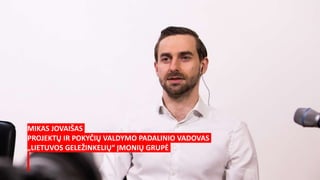M. Jovaišas. Viešojo sektoriaus lankstumas įgyvendinant transformacijas
- 1. MIKAS JOVAIŠAS PROJEKTŲ IR POKYČIŲ VALDYMO PADALINIO VADOVAS „LIETUVOS GELEŽINKELIŲ“ ĮMONIŲ GRUPĖ
- 2. FROM ZERO TO HERO – 60% RINKOS HIERARCHINĖS IR SPECIALIZUOTOS – „ORGANIZATIONS AS MACHINES“ DOMINAVO BEVEIK 100 METŲ
- 3. NUOLATINIS NAUJŲ TECHNOLOGIJŲ ĮVEDIMAS INVESTUOTOJŲ SPAUDIMAS – „PROFITABLE GROWTH“ SKAITMENIZACIJA IR DUOMENŲ PANAUDOJIMAS „ORGANIZATIONS AS ORGANISMS“
- 4. VIENAS LABIAUSIAI PAŽEIDŽIAMŲ SEKTORIŲ INFRASTRUKTŪRA, RESURSAI TAMPA MŪSŲ PAČIŲ „PRIEŠAIS“ DISRUPTIVE MODELIAI IŠPAGRINDŲ KEIČIA RINKĄ (PVZ.: VIRGIN HYPER LOOP)
- 5. PHYSICAL + DIGITAL = PHYDIGITAL TRAUKINIAI IR BÄ–GIAI NIEKUR NEDINGS, VERTÄ–S KĹŞRIMAS PER SKAITMENINIUS SPRENDIMUS MOBILUMO PLATFORMOS KONCEPCIJA
- 6. 82% STENGIASI.. TAČIAU TIK 18% KOMPANIJŲ SUGEBA KOREGUOTI STRATEGIJĄ IR ĮDIEGTI NAUJĄ ORGANIZACINĮ MODELĮ
- 7. KROVINIAI NUO 53 IKI 70 MLN. TONŲ KELEIVIAI NUO 4 IKI 8 MLN. PAJAMOS NUO 465 IKI 700 MLN. EUR EBITDA NUO 150 IKI 300 MLN. EUR
- 8. LYDERYSTĖ – „LEAD BY EXAMPLE“ STOGĄ RAUNANTI AMBICIJA FUNDAMENTALI FILOSOFIJA
- 9. DARNI BENDRUOMENĖ NAUJAS KOMPETENCIJŲ RINKINYS „ROLE MOBILITY“ STANDARTAI – „BEST PRACTICES“ ORIENTACIJA Į EFEKTYVUMĄ PERŽIŪRA IR ATNAUJIMAS VIENINGA ARCHITEKTŪRA LANKSTŪS, INOVATYVŪS, RADIKALŪS SPRENDIMAI – NO „SAMAPAL“ TECHNOLOGIJA NĖRA TIKSLAS SAVAIME
- 10. „VISION WITHOUT IMPLEMENTATION IS HALLUCINATION“
- 11. JIS GALVOJA APIE KITĄ.. KAIP REALIZUOTI STRATEGIJĄ ŽEMOJ BRANDOJ..
- 12. „TOP DOWN“ BŪDAS INVENTORIZACIJA KAS VYKDOMA + NAKTINĖS VADOVŲ SESIJOS SVOGŪNO PRINCIPU – MAŽAI DETALIŲ, ESMINIAI PRINCIPAI, TIKSLAI
- 13. EMPLOYEE EXCELLENCE PERFORMACE EXCELLENCE INFRASTRUCTURE EXCELLECE CARGO BUSINESS OPTIMISATION PASSENGER BUSINESS DEVELOPMENT SUPPLY CHAIN EXCELLENCE NEW BUSINESS DEVELOPMENT DIGITAL EXCELLENCE CORPORATE GOVERNANCE EXCELLENCE ASSET EXCELLENCE FINANCIAL EXCELLENCE 90 PROJEKTŲ
- 15. „BARE MINIMUM“ SUSITARIMAI – VALDYSENA, POLITIKA, METODIKA, PROCESAI ETAPIŠKUMAS – SUPRASKIME ARTIMIAUSIĄ ETAPĄ SUFORMUOTOS MATRICINĖS KOMANDOS, PARTNERIAI – KOMANDŲ DALIS „YOU GET WHAT YOU MEASURE“ 100% IT TEKAMUMAS, 70% PAKEISTŲ/NAUJŲ PROJEKTŲ VADOVŲ, 35% NAUJŲ PROJEKTO SAVININKŲ
- 16. 30 PROJEKTŲ ĮGYVENDINTI, 80% - PIRKIMŲ AR ĮGYVENDINIMO STADIJOJE IDENTIFIKUOTA PORTFELIO NAUDŲ UŽ 350 MLN. EUR AND COUNTING KULTŪRA: PMO OFISAI DUKTERINĖSE ĮMONĖSE, NEFORMALI 400+ PROJEKTŲ ENTUZIASTŲ BENDRUOMENĖ, PADIDĖJUSI BRANDA IKI 3 STABILIZUOTA RESURSŲ BAZĖ – POREIKIS VIS AUGA DEJA.. PROJEKTŲ ĮGYVENDINIMO LAIKU DISCIPLINA TAISYTINA
- 17. NEBUS POKYČIO – JEIGU NEBUS DISCIPLINUOTO VALDYMO KAI GALVOJOME, KAD PABAIGA – TAI TIK PRADŽIA DIEVAS PASAULĮ SUKŪRĖ PER 7 ITERACIJAS – NUOLAT ITERUOSIME IR MES
- 18. AČIŪ UŽ DĖMESĮ! RANKŲ MIŠKAS – KLAUSIMAI?
Editor's Notes
- #3: Henry Fordas: 1910 For buvo maža kompanija 1920 turėjo 60% market share 12 valandų iki 90 minučių, nuo 800$ iki 350$ Taylor pavadinimo hierarchinės ir specializuotos ir beveik 100 metų dominavo prieš kitu modelius Ford’s ideas, and those of his contemporary, Frederick Taylor, issued from scientific management, a breakthrough insight that optimized labor productivity using the scientific method; it opened an era of unprecedented effectiveness and efficiency. Taylor’s ideas prefigured modern quality control, total-quality management, and—through Taylor’s student Henry Gantt—project management. Gareth Morgan describes Taylorist organizations such as Ford as hierarchical and specialized—depicting them as machines.2 For decades, organizations that embraced this machine model and the principles of scientific management dominated their markets, outperformed other organizations, and drew the best talent. From Taylor on, 1911 to 2011 was “the management century.”
- #4: Tai kas lėmė, kad nuo 2011 m. šis modelis nebebuvo efektyviausias organizacijų valdymui Quickly evolving environment. All stakeholders’ demand patterns are evolving rapidly: customers, partners, and regulators have pressing needs; investors are demanding growth, which results in acquisitions and restructuring; and competitors and collaborators demand action to accommodate fast-changing priorities. Constant introduction of disruptive technology. Established businesses and industries are being commoditized or replaced through digitization, bioscience advancements, the innovative use of new models, and automation. Examples include developments such as machine learning, the Internet of Things, and robotics. Accelerating digitization and democratization of information. The increased volume, transparency, and distribution of information require organizations to rapidly engage in multidirectional communication and complex collaboration with customers, partners, and colleagues. The new war for talent. As creative knowledge- and learning-based tasks become more important, organizations need a distinctive value proposition to acquire—and retain—the best talent, which is often more diverse. These “learning workers” often have more diverse origins, thoughts, composition, and experience and may have different desires (for example, millennials).
- #7: According to our research with 1,900 executives, they are adapting their strategy (and their organizational structure) with greater frequency than in the past. Eighty-two percent of them went through a redesign in the last three years. However, most of these redesign efforts fail—only 18 percent were implemented successfully


















